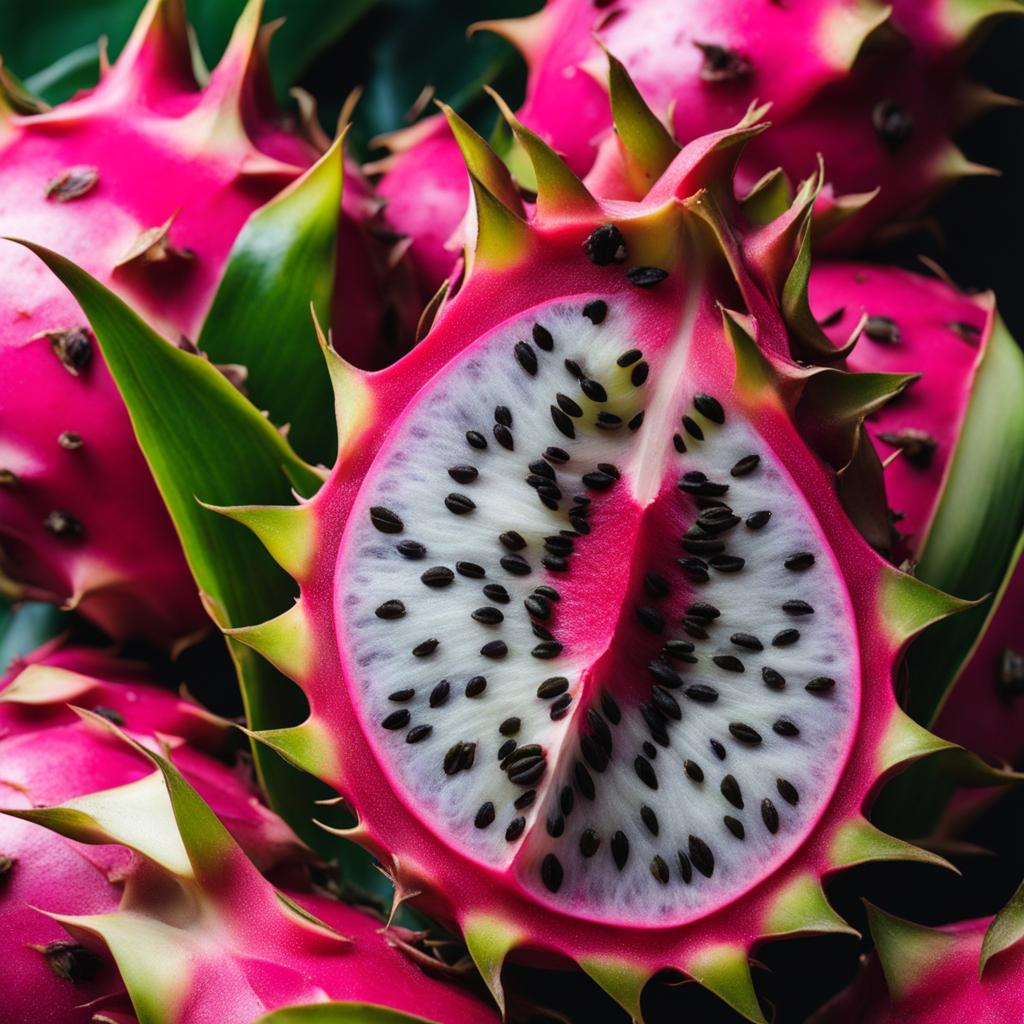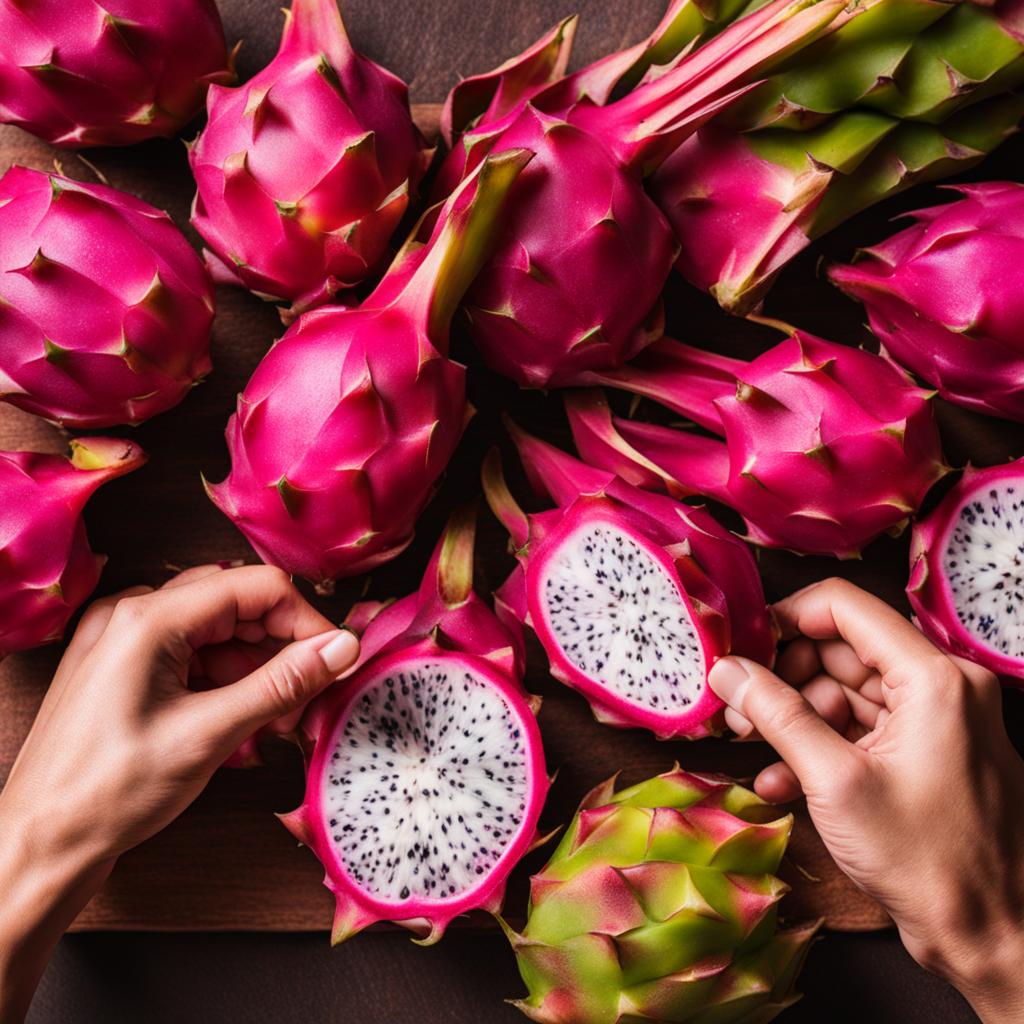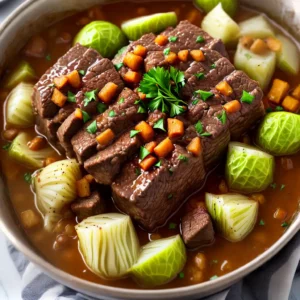Welcome to my guide on how to pick the perfect dragon fruit by identifying the ripe signs. Dragon fruit, with its vibrant colors and unique flavor, is a delicious tropical fruit that can add a touch of exoticism to your culinary adventures. But how do you know when a dragon fruit is ripe and ready to enjoy? In this article, I will share some valuable tips and tricks to help you determine the ripeness of dragon fruit, ensuring you pick the best ones every time.
Key Takeaways:
- Dragon fruit comes in a range of colors, such as red or yellow, when ripe.
- The outer skin should be bright and even-colored, without excessive dark blotches.
- The wings on the fruit should start to wither and turn brown when it is ripe.
- The flesh of a ripe dragon fruit should be juicy yet firm, resembling a cross between a melon and a pear.
- By considering visual and tactile cues, as well as understanding the ripening process and freshness factors, you can pick the perfect dragon fruit.
Visual Cues of Ripeness
When it comes to determining the ripeness of a dragon fruit, visual cues play a crucial role. By carefully observing the outer appearance of the fruit, you can gauge its level of ripeness. A ripe dragon fruit will exhibit vibrant and even colors, such as a rich red or golden yellow, depending on the variety. The skin should be smooth and free from excessive blemishes, indicating a fresh and ripe fruit.
One visual cue to look out for is the presence of dark blotches on the skin. While some small spots are normal, an abundance of dark blotches could indicate overripeness. Additionally, pay attention to the wings of the fruit, which are the leafy parts extending off of it. As the dragon fruit ripens, these wings will start to wither and turn brown.
By closely examining the visual cues, you can confidently select a ripe dragon fruit that is ready to be enjoyed. Remember, a visually appealing and vibrant dragon fruit is often an indication of its delicious flavor and optimal ripeness.
Tactile Cues of Ripeness
When it comes to determining the ripeness of a dragon fruit, your sense of touch can be a valuable tool. By giving the fruit a gentle squeeze, you can assess its texture and firmness to gauge its ripeness.
A ripe dragon fruit should have a slight give when you apply pressure, similar to a ripe avocado. If the fruit feels too firm, it is not yet ripe and needs more time to develop its flavors. On the other hand, if the fruit feels excessively mushy or soft, it may be overripe and past its prime.
Remember to handle the fruit delicately to avoid damaging the skin or bruising the flesh. A gentle squeeze can provide valuable tactile cues that indicate whether a dragon fruit is ripe and ready to be enjoyed.
As with any fruit, the tactile cues of ripeness should be used in conjunction with other visual and olfactory signs to ensure the dragon fruit is at its peak flavor. By combining these cues, you can confidently select a perfectly ripe dragon fruit for your culinary creations or enjoy it on its own for a refreshing treat.
Cutting Open a Dragon Fruit
When it comes to enjoying the delicious flesh of a dragon fruit, knowing how to properly cut it open is essential. Follow these simple steps to prepare your dragon fruit for consumption:
- Rinse the dragon fruit to remove any dirt or debris from the skin.
- Using a sharp knife, carefully cut the fruit in half lengthwise.
- Take a moment to admire the vibrant colors and unique texture of the fruit.
- You can choose to eat the pulp straight out of the skin with a spoon, enjoying the refreshing juiciness.
- If you prefer to remove the fruit from the skin, use a spoon to gently scoop out the flesh.
- Alternatively, you can cut the flesh into smaller pieces for snacking or incorporating into various dishes.
Now that you know how to cut open a dragon fruit, you can indulge in its delightful taste and texture. Don’t forget to savor the visual appeal of the fruit as you enjoy its unique flavor!
| Step | Instructions | |
|---|---|---|
| Method | Alternative Option | |
| 1 | Rinse the dragon fruit to remove any dirt or debris from the skin. | – |
| 2 | Using a sharp knife, carefully cut the fruit in half lengthwise. | – |
| 3 | Take a moment to admire the vibrant colors and unique texture of the fruit. | – |
| 4 | You can choose to eat the pulp straight out of the skin with a spoon, enjoying the refreshing juiciness. | – |
| 5 | – | If you prefer to remove the fruit from the skin, use a spoon to gently scoop out the flesh. |
| 6 | – | Alternatively, you can cut the flesh into smaller pieces for snacking or incorporating into various dishes. |
Picking Dragon Fruit at the Right Time
When it comes to picking dragon fruit, timing is everything. Harvesting the fruit at the right moment ensures optimal taste and texture. So, how do you know when it’s the right time to pick dragon fruit?
Visual Cues
One way to determine if a dragon fruit is ready to be picked is by observing its color. The fruit changes from green to a vibrant yellow or red when it reaches its peak ripeness. Look for a consistent and even coloration on the outer skin. Avoid fruits with excessive dark spots or blemishes, as they may indicate overripeness.
Wings withering
The wings, or leafy parts, on the sides of the fruit also provide valuable visual cues. As the fruit ripens, the wings will start to fade or turn brown. This signifies that the fruit is undergoing the natural ripening process and is nearing its prime state.
Tactile Assessment
In addition to visual cues, a gentle touch can also help you determine if the dragon fruit is ready to be picked. A ripe dragon fruit should have a slight give when gently squeezed. It should feel slightly soft, similar to a ripe avocado. If the fruit is too firm, it needs more time to ripen. On the other hand, if it feels mushy or excessively soft, it may be overripe.
By considering these visual and tactile cues, you can confidently pick dragon fruit at the right time, ensuring a delightful culinary experience.
| Visual Cues | Tactile Assessment |
|---|---|
| Color changes from green to yellow or red | Fruit should have a slight give when gently squeezed |
| Consistent and even coloration on the outer skin | Texture should be slightly soft, like a ripe avocado |
| Avoid fruits with excessive dark spots or blemishes | Firmness indicates ripeness – not too firm, not too mushy |
| Wings on the fruit start to fade or turn brown |
Harvesting Dragon Fruit
Harvesting dragon fruit is an exciting and rewarding process that allows you to enjoy the fruits of your labor. To ensure that you pick dragon fruit at the right time, it’s essential to pay attention to visual cues, such as changes in color and the withering of wings. Additionally, by following the proper harvesting techniques, you can ensure that the fruit is ripe and ready to be enjoyed.
When harvesting dragon fruit, look for signs that indicate the fruit is close to being fully ripe. The small leaves, or wings, on the sides of the fruit will begin to fade or turn brown, indicating that the fruit is reaching its peak ripeness. It’s also important to remove the thorns from the fruit before picking. This can be done using pliers or gloves to protect your hands.
Harvesting Dragon Fruit – Step by Step
- Inspect the fruit: Look for faded or brown wings on the fruit, indicating ripeness.
- Remove thorns: Use pliers or gloves to remove the thorns from the fruit.
- Detach the fruit: Gently twist the fruit to detach it from the vine.
- Inspect for readiness: If the fruit doesn’t come off easily, it may not be fully ripe.
By following these steps, you can ensure that you harvest dragon fruit at the right time, resulting in the best quality and flavor.
| Visual Cues of Ripeness | Tactile Cues of Ripeness |
|---|---|
| Changes in skin color | Slightly soft to the touch |
| Fading or browning wings | Firm, but not too firm |
Remember, harvesting dragon fruit at the optimal time ensures that you enjoy the fruit’s delicious taste and vibrant colors. So, get ready to savor the sweet and refreshing flavors of freshly harvested dragon fruit!
https://www.youtube.com/watch?v=1b85wd8lpKs
Storage and Shelf Life of Dragon Fruit
When it comes to storing dragon fruit, there are a few options to consider. You can store it in the refrigerator or at room temperature, depending on your preferences and the level of ripeness you desire. Storing dragon fruit in the refrigerator will help slow down the ripening process, while leaving it on the counter will allow it to continue ripening.
If you choose to refrigerate your dragon fruit, place it in a plastic bag or container to prevent moisture loss and keep it fresh. This will help extend its shelf life and maintain its texture and flavor. However, keep in mind that refrigeration can cause the fruit’s vibrant color to dull slightly. So, if presentation is important to you, consider storing it at room temperature instead.
Once you have cut open a dragon fruit, it is best to consume it immediately or store it in an airtight container in the refrigerator for a day or two. This will help preserve its freshness and prevent it from spoiling. As with any fruit, the flavor and texture of dragon fruit may deteriorate after being cut, so it is best to enjoy it as soon as possible.
Table: Storage Recommendations for Dragon Fruit
| Storage method | Temperature | Shelf life |
|---|---|---|
| Room temperature | Around 70°F (21°C) | 1-2 days |
| Refrigerator | Between 40-45°F (4-7°C) | Up to 4 days |
It’s worth noting that frozen dragon fruit can be stored for up to six months. Freezing the fruit is a great option if you have an abundance of dragon fruit and want to enjoy it throughout the year. To freeze dragon fruit, simply cut it into chunks or slices, place them in a freezer-safe bag or container, and store it in the freezer.
Remember to label the container with the freezing date to ensure you use it within the recommended time frame. Frozen dragon fruit can be added to smoothies, used in desserts, or enjoyed as a frozen treat on its own.
When it comes to storing dragon fruit, it’s important to consider the level of ripeness you desire and the best storage method to maintain its freshness. Whether you choose to store it in the refrigerator or at room temperature, proper storage will help extend its shelf life and preserve its flavor and texture.
Appearance and Color of Dragon Fruit
Dragon fruit is known for its visually stunning appearance, with its vibrant pink skin and unique shape. The skin of a dragon fruit should be smooth and free of excessive blemishes or bruises. When selecting a dragon fruit, look for one that has a bright and even color, indicating that it is ripe and ready to be enjoyed. The color of the flesh depends on the variety, with white-fleshed dragon fruit having larger scales and pink or red-fleshed dragon fruit having smaller scales. This contrasting color and texture make dragon fruit an eye-catching addition to any dish or fruit platter.
Taste the Rainbow
Dragon fruit comes in a range of colors, from the vibrant pink to the more muted yellow varieties. Each color offers a slightly different flavor profile, adding to the versatility of this exotic fruit. The pink and red varieties tend to have a sweeter taste, while the yellow varieties are often described as more tropical and citrusy. Regardless of the color, dragon fruit is known for its refreshing and slightly sweet flavor, making it a delightful treat for the taste buds.
A Feast for the Eyes
In addition to its vibrant color, dragon fruit’s unique appearance adds a touch of elegance to any dish. The contrasting colors of the bright pink or yellow skin and the white, pink, or red flesh create a visually appealing presentation. When sliced, the dragon fruit reveals a speckled flesh that resembles a work of art. Whether used as a garnish, added to a fruit salad, or enjoyed on its own, dragon fruit will surely impress both your eyes and your taste buds.
Colorful Creations
Dragon fruit’s beautiful colors make it a popular ingredient in various culinary creations. The vibrant pink or yellow flesh can add a pop of color to smoothie bowls, fruit salads, and desserts. Its mild and refreshing flavor complements other tropical fruits and pairs well with creamy ingredients like coconut or yogurt. The striking appearance and exotic appeal of dragon fruit make it a popular choice for those looking to create visually stunning and delicious dishes.
| Appearance | Color |
|---|---|
| Smooth and free of blemishes | Bright and even |
| Unique shape with vibrant pink skin | Varies based on variety – pink, red, or yellow |
| Contrasting texture with large or small scales | White, pink, or red |
Taste and Flavor of Dragon Fruit
When it comes to taste, dragon fruit offers a delightful and unique flavor profile that is sure to excite your palate. With its combination of sweet and tangy notes, dragon fruit is often likened to a cross between pears and kiwis, with a hint of citrus. The flesh of a ripe dragon fruit is slightly sweet and refreshing, making it a perfect choice for those seeking a light and flavorful treat.
Whether enjoyed on its own or incorporated into various dishes, dragon fruit adds a burst of freshness and vibrancy. Its texture resembles that of a ripe kiwi, with a tender yet slightly crunchy bite. The visually stunning color of dragon fruit, ranging from white to pink or red, adds a touch of elegance to any presentation.
“Dragon fruit has a unique taste that is often compared to a combination of pears and kiwis, with a hint of citrus.”
Dragon fruit can be the star ingredient in a variety of culinary creations. Blend it into smoothies for a refreshing and nutritious beverage. Add it as a topping to yogurt or desserts for a burst of flavor. Incorporate it into fruit salads for a visually appealing and delicious twist. The possibilities are endless, allowing you to explore and experiment with the versatility of this exotic fruit.
The Taste and Flavor of Dragon Fruit at a Glance:
- Unique flavor combining sweet and tangy notes
- Resembles a cross between pears and kiwis, with a hint of citrus
- Slightly sweet and refreshing
- Texture similar to a ripe kiwi
- Visually stunning with a range of colors
- Can be enjoyed on its own or used in various dishes
Tasting Table:
| Variety | Taste | Flavor |
|---|---|---|
| White Fleshed | Subtle sweetness | Light and refreshing |
| Pink Fleshed | Mild sweetness | Tropical and floral |
| Red Fleshed | Slightly tart | Bold and tangy |
Nutritional Value of Dragon Fruit
Dragon fruit is not only a visually appealing fruit but also a nutritional powerhouse. Packed with antioxidants, fiber, and various vitamins and minerals, dragon fruit offers numerous health benefits.
The following table highlights the key nutritional components of dragon fruit:
| Nutrient | Amount per 100g |
|---|---|
| Calories | 60 |
| Carbohydrates | 9g |
| Fiber | 1g |
| Vitamin C | 9mg |
| Vitamin A | 20mcg |
| Iron | 0.65mg |
| Magnesium | 36mg |
Dragon fruit is particularly rich in vitamin C, which plays a crucial role in immune function and collagen production. It also contains significant amounts of vitamin A, which is essential for healthy vision and immune system support. Additionally, dragon fruit offers iron and magnesium, essential minerals involved in various bodily functions.
By incorporating dragon fruit into your diet, you can enjoy its unique flavor while reaping the benefits of its nutritional value. Whether eaten on its own or used in various recipes, dragon fruit is a tasty and healthy addition to any meal.

Culinary Uses and Recipes with Dragon Fruit
Dragon fruit is not only visually stunning but also versatile when it comes to culinary creations. Its unique flavor and vibrant color make it a popular choice for a variety of recipes. Whether you’re looking for a refreshing smoothie, a vibrant salad, or a delicious dessert, dragon fruit can add a touch of sweetness and beauty to any dish.
Smoothies and Bowl Creations
One of the most popular ways to enjoy dragon fruit is by blending it into a smoothie or using it as a topping for smoothie bowls. The creamy texture and slightly sweet taste of dragon fruit pair well with other fruits like bananas, berries, and mangoes. Add some coconut water or almond milk for a refreshing and tropical twist. Top your smoothie bowl with dragon fruit slices, granola, and coconut flakes for an Instagram-worthy breakfast or snack.
Fresh Salads
Dragon fruit can also be a beautiful and nutritious addition to fresh salads. Its vibrant color and mild flavor complement a wide range of salad ingredients. Toss together some baby spinach, arugula, or mixed greens with dragon fruit slices, avocado, cherry tomatoes, and a sprinkle of feta cheese. Drizzle with a tangy dressing like balsamic vinaigrette or citrus dressing for a refreshing and satisfying salad.
Desserts and Sweet Treats
When it comes to desserts, dragon fruit can be a showstopper. Its vibrant pink or red flesh adds a pop of color to any sweet treat. You can use dragon fruit puree to make popsicles, sorbets, or even a dragon fruit cheesecake. For a simple yet elegant dessert, serve dragon fruit slices with a dollop of whipped cream or coconut yogurt. The subtle sweetness and refreshing taste of dragon fruit will leave you wanting more.
| Recipe | Description |
|---|---|
| Dragon Fruit Smoothie | A refreshing and nutritious smoothie made with dragon fruit, bananas, and coconut water. |
| Dragon Fruit Salad | A colorful and flavorful salad featuring dragon fruit, avocado, cherry tomatoes, and feta cheese. |
| Dragon Fruit Popsicles | A sweet and refreshing frozen treat made with dragon fruit puree and coconut milk. |
| Dragon Fruit Cheesecake | A creamy and indulgent dessert with a crust made from crushed cookies and a dragon fruit-infused cheesecake filling. |
Get creative with dragon fruit and explore the endless possibilities in the kitchen. Whether you’re making smoothies, salads, or desserts, this exotic fruit will add a unique touch to your culinary creations. So, grab a dragon fruit and let your imagination run wild!
Exotic Fruit Kitchen Hacks
Working with exotic fruits like dragon fruit can be a delightful and adventurous experience in the kitchen. Here are some kitchen hacks to make incorporating dragon fruit into your culinary routine a breeze:
1. Easy Slicing
Dragon fruit has a thick, leathery skin that can be challenging to cut through. To make slicing easier, start by cutting off the ends of the fruit to create stable surfaces. Then, using a sharp knife, carefully slice the fruit lengthwise in half. You can also slice the fruit into wedges or cubes, depending on your recipe.
2. Frozen Delights
Freezing dragon fruit is a great way to extend its shelf life and create delicious frozen treats. Simply peel the fruit, slice it into desired shapes, and place the slices on a baking sheet lined with parchment paper. Freeze the dragon fruit for a few hours, then transfer the frozen slices to a freezer-safe container. Use the frozen dragon fruit in smoothies, sorbets, or as a refreshing addition to drinks.
3. Vibrant Salad Topping
Dragon fruit adds a pop of color and subtle sweetness to your salads. To create a vibrant salad topping, dice the fruit into small cubes and sprinkle them over your favorite greens. The dragon fruit’s juicy and refreshing flavor pairs well with leafy greens, such as spinach or arugula, and complements other fruits and vegetables.
| Hack | Description |
|---|---|
| Easy Slicing | Make cutting dragon fruit a breeze by cutting off the ends and slicing lengthwise. |
| Frozen Delights | Create delicious frozen treats by freezing peeled and sliced dragon fruit. |
| Vibrant Salad Topping | Add a pop of color and sweetness to your salads with diced dragon fruit. |
With these kitchen hacks, you can confidently incorporate exotic fruits like dragon fruit into your culinary repertoire. Whether you’re slicing it with ease, freezing it for refreshing treats, or using it to add vibrancy to your salads, dragon fruit is sure to bring a touch of exotic flair to your dishes.
Identifying Dragon Fruit Ripening Process
To determine the ripeness of a dragon fruit, it’s important to pay attention to key visual, tactile, and olfactory cues. These indicators can help you choose a perfectly ripe fruit that is bursting with flavor and ready to be enjoyed. Here are the essential factors to consider when identifying the ripening process of dragon fruit:
Visual Cues
The first visual cue of ripeness is the color of the outer skin. A ripe dragon fruit will have a vibrant and even color, such as deep shades of red, pink, or yellow, depending on the variety. Avoid fruits with dark blotches or excessive blemishes, as these may indicate overripeness. Additionally, look for withered wings on the fruit, which are the leafy parts extending off of it. When the wings start to turn brown and wither, it’s a clear sign that the fruit is ripe and ready to be enjoyed.
Tactile Cues
Gently squeeze the dragon fruit to assess its ripeness. A ripe dragon fruit should be slightly soft to the touch, yielding to gentle pressure, similar to a ripe avocado or peach. If the fruit feels too firm, it needs more time to ripen. On the other hand, if it feels excessively mushy or squishy, it may be overripe. Finding the perfect balance of firmness is key to enjoying the optimal texture and taste of a ripe dragon fruit.
Olfactory Cues
Lastly, the aroma of a ripe dragon fruit can provide valuable clues about its ripeness. As the fruit ripens, its sweet, tropical scent becomes more pronounced. Take a moment to smell the fruit near the stem or at the base, and if you’re met with a delightful, fragrant aroma, it’s a good indication that the dragon fruit is ripe and ready to be enjoyed.

| Visual Cues | Tactile Cues | Olfactory Cues |
|---|---|---|
| A bright and even color | Slightly soft to the touch | Pronounced sweet aroma |
| Withered wings | Yielding to gentle pressure | Fragrant scent near the stem |
| Avoid dark blotches or blemishes | Avoid excessive mushiness |
By combining these visual, tactile, and olfactory cues, you can confidently identify the ripening process of dragon fruit and choose the perfect fruit for your next culinary masterpiece or refreshing snack.
The Freshness Factor of Dragon Fruit
When it comes to enjoying the best possible dragon fruit, freshness is key. The quality and taste of this exotic fruit depend greatly on its freshness. By selecting a fresh dragon fruit, you can enhance your culinary experience and fully savor its unique flavor profile.
So, how can you determine the freshness of a dragon fruit? Start by examining the skin. Look for a fruit with bright, even-colored skin that is free from excessive blemishes or dark spots. Avoid fruits that have dried out stems or show signs of damage or bruising.
Additionally, consider the wings of the dragon fruit. These leafy extensions should be vibrant and show no signs of withering. A fresh dragon fruit will have wings that are still green and healthy-looking.
| Freshness Indicators | Signs of Freshness | Signs of Unfreshness |
|---|---|---|
| Skin | Bright and even-colored | Excessive blemishes or dark spots |
| Stem | Moist and intact | Dried out or missing |
| Wings | Vibrant and green | Withered or brown |
Table: Freshness indicators for dragon fruit.
Remember, the freshness of dragon fruit can significantly impact its taste and overall quality. So, choose wisely and enjoy the delightful flavors of this tropical fruit at its best.
Conclusion
In conclusion, identifying the ripe signs of a dragon fruit is crucial for enjoying this exotic and delicious fruit. By considering visual and tactile cues, as well as understanding the ripening process and freshness factors, you can pick the perfect dragon fruit and fully appreciate its unique taste, texture, and nutritional benefits in various culinary creations.
When determining the ripeness of a dragon fruit, look for visual cues such as the color of its outer skin. A ripe dragon fruit will have a vivid, even color, such as red or yellow, depending on the variety. Dark blotches on the skin may indicate overripeness. Additionally, check for withered wings on the fruit, as this is a visual sign of ripeness.
Tactile cues are also important in assessing the ripeness of a dragon fruit. A ripe dragon fruit should feel slightly soft to the touch, similar to a ripe avocado. If the fruit feels too firm, it needs more time to ripen. Conversely, if it feels mushy, it is likely overripe.
By understanding these ripe signs and incorporating them into your selection process, you can confidently choose the perfect dragon fruit for your culinary adventures. So embrace the vibrant world of dragon fruit and savor its juicy and refreshing goodness!
FAQ
How can I tell if a dragon fruit is ripe?
You can determine if a dragon fruit is ripe by checking the color of its outer skin. A ripe dragon fruit will have a vivid, even color, such as red or yellow, with minimal dark blotches. The wings on the fruit should start to wither and turn brown. Additionally, when you cut open a dragon fruit, the flesh should be juicy yet firm, resembling a cross between a melon and a pear.
What are the visual cues of ripeness for dragon fruit?
Visual cues of ripeness for dragon fruit include a bright, even-colored outer skin without excessive dark blotches. The wings on the fruit should start to wither and turn brown as well.
What are the tactile cues of ripeness for dragon fruit?
To assess the ripeness of a dragon fruit, give it a gentle squeeze. A ripe dragon fruit should be slightly soft to the touch, akin to a ripe avocado. If the fruit feels too firm, it needs more time to ripen. On the other hand, if it feels mushy, it is likely overripe.
How do I cut open a dragon fruit?
To cut open a dragon fruit, rinse it off to remove any dirt or debris. Use a sharp knife to cut the fruit in half lengthwise. You can choose to eat the pulp straight out of the skin with a spoon or remove the fruit from the skin. If removing the fruit, you can scoop out the flesh with a spoon or cut it into smaller pieces.
When is the right time to pick dragon fruit?
Dragon fruit should be harvested when it is close to fully ripe. The color of the fruit changes from green to yellow or red when it is ready to be picked. The wings on the sides of the fruit will also start to fade or turn brown as it ripens.
How do I harvest dragon fruit?
To harvest dragon fruit, ensure the fruit is close to being fully ripe. The small leaves, or wings, on the sides of the fruit will begin to fade or turn brown. Remove the thorns from the fruit before picking, using pliers or gloves. Detach the dragon fruit from the vine by twisting it gently. If it doesn’t come off easily, it may not be ready to be harvested.
How should I store dragon fruit?
Dragon fruit can be stored in the refrigerator or at room temperature. Storing it in the refrigerator will slow down the ripening process, while leaving it on the counter will allow it to continue ripening. Once cut, dragon fruit should be consumed immediately or stored in an airtight container in the refrigerator for a day or two. Frozen dragon fruit can be stored for up to six months.
What should the appearance and color of dragon fruit be?
Dragon fruit has a visually stunning appearance, with bright pink skin and white, pink, or red flesh. The skin should be smooth and free of excessive blemishes. The color of the flesh depends on the variety, with white-fleshed dragon fruit having larger scales and pink or red-fleshed dragon fruit having smaller scales.
How would you describe the taste and flavor of dragon fruit?
Dragon fruit has a unique taste that is often compared to a combination of pears and kiwis, with a hint of citrus. The flesh of a ripe dragon fruit is slightly sweet and refreshing, resembling the texture of a ripe kiwi. It can be enjoyed on its own or incorporated into various dishes, such as smoothies, yogurt bowls, or fruit salads.
What is the nutritional value of dragon fruit?
Dragon fruit is a nutritious fruit that is low in calories but rich in antioxidants, fiber, and various vitamins and minerals. It contains iron, magnesium, calcium, vitamin C, and vitamin A, among other beneficial nutrients. Incorporating dragon fruit into your diet can contribute to overall health and well-being.
How can dragon fruit be used in culinary creations?
Dragon fruit is a versatile fruit that can be used in a variety of culinary creations. It can be blended into smoothies, used as a topping for yogurt or desserts, or incorporated into savory dishes for a touch of sweetness. There are numerous recipes available that showcase the unique flavor and vibrant color of dragon fruit.
Are there any kitchen hacks for working with dragon fruit?
Yes, there are various kitchen hacks that can make working with dragon fruit more convenient and enjoyable. From slicing and dicing to freezing and storing, these hacks can help you incorporate dragon fruit into your daily cooking routine with ease.
How can I identify the ripening process of dragon fruit?
The ripening process of dragon fruit can be identified through various visual, tactile, and olfactory cues. Pay attention to changes in color, the withering of wings, and the texture of the fruit when determining ripeness. The aroma of a ripe dragon fruit may also become more pronounced as it ripens.
How important is the freshness factor of dragon fruit?
The freshness of dragon fruit is crucial to its overall taste and quality. To ensure the freshest dragon fruit, look for bright, even-colored skin without excessive blemishes. Avoid fruits that have dried out stems or show signs of damage or blemishes. Choosing a fresh dragon fruit will enhance your culinary experience.
Source Links
- https://www.ediblearrangements.com/blog/how-to-cut-dragon-fruit/
- https://www.wikihow.com/Tell-if-a-Dragon-Fruit-Is-Ripe
- https://www.realsimple.com/food-recipes/cooking-tips-techniques/how-to-eat-dragon-fruit
Related Recipes:
 How to Cut Dragon Fruit? (Perfect Step-By-Step Guide)
How to Cut Dragon Fruit? (Perfect Step-By-Step Guide)
 Identifying Ripe Bananas: A Quick Guide
Identifying Ripe Bananas: A Quick Guide
 Signs of a Ripe Cantaloupe
Signs of a Ripe Cantaloupe
 How to Freeze Passion Fruit? (Step-By-Step Guide)
How to Freeze Passion Fruit? (Step-By-Step Guide)
 How to Determine Mango Ripeness
How to Determine Mango Ripeness
 How to Store Kiwi for Peak Ripeness
How to Store Kiwi for Peak Ripeness
 How to Make Candied Fruit (Easy Step-by-Step Guide)
How to Make Candied Fruit (Easy Step-by-Step Guide)
 How to Cut a Kiwi? (Perfect Step-By-Step Guide)
How to Cut a Kiwi? (Perfect Step-By-Step Guide)







